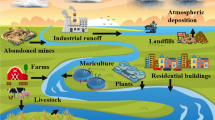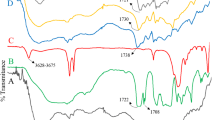Abstract
Byssus threads are tough biopolymer produced by mussels (Mytilus viridis) to attach themselves to rocks. These were collected from mussels in their natural habitat (N) and from animals maintained in laboratory condition (L) as a novel support. Byssus thread surfaces were characterized by SEM analysis, chemically modified and used for adsorption of urease. The efficiency of the immobilization was calculated by examining the relative enzyme activity of free and the immobilized urease. The pH stabilities of immobilized urease were higher (0.5 unit) than free enzyme. Immobilized enzymes on byssus (both N and L) when stored at 6 °C retained 50% of its activity after 30 days, but they were more stable in dry condition. The optimum temperature of immobilized enzymes was found to increase (25 °C). A Michaelis–Menten constant (K m) value for immobilized urease was also elevated (2.08 mol).






Similar content being viewed by others
References
Hanefeld, U., Gardossib, L., & Magnerc, E. (2009). Chemical Society Reviews, 38, 453–468.
Schoemaker, H. E., Mink, D., & Wubbolts, M. G. (2003). Science, 299, 1694–1697.
Iyer, P. V., & Ananthanarayan, L. (2008). Process Biochemistry, 43, 1019–1032.
Marconi, W. (1989). Reactive Polymers, 11, 1–19.
Taylor, R. F. (1991). Protein immobilization fundamentals and applications (p. 269). New York: Marcel Deckker.
Klibanov, A. M. (1983). Science, 219, 722–727.
Bhole, M., & Bahadur, A. (1990). Cellulose Chemistry and Technology, 24, 563–570.
Bahadur, A., & Bahadur, P. (1985). Indian Journal of Biochemistry and Biophysics, 22, 107–110.
DeGroot, A. R., & Neufeld, R. J. (2001). Enzyme and Microbial Technology, 29, 321–327.
Atkinson, B. R. J., & Rousseau, I. (1977). Biotechnology and Bioengineering, 19, 1037–1041.
Nouaimi, M., Moschel, K., & Bisswanger, H. (2001). Enzyme and Microbial Technology, 29, 567–574.
Jia, H. F., Zhu, G. Y., Vugrinovich, B., Kataphinan, B., Reneker, D. H., & Wang, P. (2002). Biotechnology and Bioengineering, 18, 1027–1032.
Teramoto, K., Nakamoto, Y., Kumitomo, T., Shoji, H., Tani, T., Hanazawa, K., et al. (2002). Therapeutic Apheresis, 6, 103–108.
Zhang, Y. Q. (1998). Biotechnology Advances, 16, 961–971.
Xie, J. B., & Hsich, Y. L. (2003). Journal of Materials Science, 38, 2125–2133.
Krajewska, B. (2009). Journal of Molecular Catalysis B: Enzymatic, 59, 9–21.
Krajewska, B. (2009). Journal of Molecular Catalysis B: Enzymatic, 59, 22–40.
Pithawala, K., & Bahadur, A. (2004). National Academy Science Letters, 27, 53–58.
Reddy, R. C., Srivastava, P. K., Dey, P. M., & Kayastha, A. M. (2004). Biotechnology and Applied Biochemistry, 39, 323–327.
Pithawala, K., Mishra, N., & Bahadur, A. (2010). Journal of the Serbian Chemical Society, 75, 175–183.
Prakash, O., Puliga, S., & Upadhyay, L. S. (2007). Biotechnology and Bioprocess Engineering, 12, 131–135.
Waite, J. H. (2002). Integrative and Comparative Biology, 42, 1172–1180.
Bromley, R. G., & Heinberg, C. (2006). Palaeogeography, Palaeoclimatology, Palaeoecology, 232, 429–453.
Qin, X., Coyne, K. J., & Waite, J. H. (1997). Journal of Biological Chemistry, 272, 32623–32627.
Qin, X. X., & Waite, J. H. (1998). Proceedings of the National Academy of Sciences of the United States of America, 95, 10517–10522.
Lowry, O. H., Rosebrough, N. J., Farr, A., & Randall, R. W. (1951). Journal of Biological Chemistry, 193, 265–275.
Jayaraman, J. (1981). Laboratory manual in biochemistry (p. 130). New Delhi: Wiley.
Gonzalez, J. M., & Pizarro, C. (2001). European Polymer Journal, 37, 435–444.
Krajewska, B., & Piwowarska, Z. (2005). Biocatalysis and Biotransformation, 23, 225–232.
Sahoo, B., Sahu, S. K., & Pramanik, P. (2011). Journal of Molecular Catalysis B: Enzymatic, 69, 95–102.
Kumar, S., Dwevedi, A., & Kayastha, A. M. (2009). Journal of Molecular Catalysis B: Enzymatic, 58, 138–145.
Kallury, K. M. R., Lee, W. E., & Thompson, M. (1992). Analytical Chemistry, 64, 1062–1068.
Arasaratnam, V., Galaev, I. Y., & Matiasson, B. (2000). Enzyme and Microbial Technology, 27, 254–263.
Bissett, F., & Sternberg, D. (1978). Applied and Environmental Microbiology, 35, 750–755.
Dickensheets, P. A., Chen, L. F., & Tsao, G. T. (1977). Biotechnology and Bioengineering, 19, 365–375.
Acknowledgments
Anita Bahadur thanks U.G.C. India Major Research Project [F.No.33-347/2007 (SR)] for financial assistance.
Author information
Authors and Affiliations
Corresponding author
Rights and permissions
About this article
Cite this article
Mishra, N., Pithawala, K. & Bahadur, A. Byssus Thread: A Novel Support Material for Urease Immobilization. Appl Biochem Biotechnol 165, 1568–1576 (2011). https://doi.org/10.1007/s12010-011-9376-y
Received:
Accepted:
Published:
Issue Date:
DOI: https://doi.org/10.1007/s12010-011-9376-y




